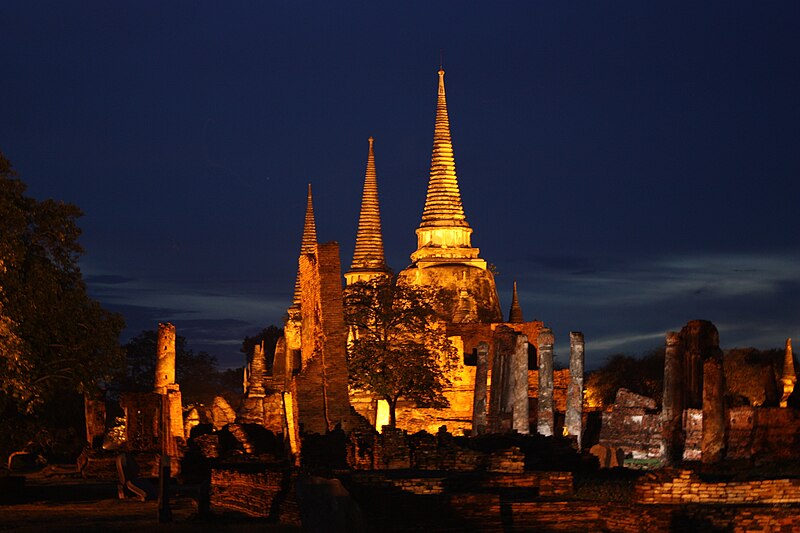Wat Phra Sri Sanphet (Thai: วัดพระศรีสรรเพชญ์) is situated on the City Island in Ayutthaya’s World Heritage Park in Pratuchai sub-district. It has been registered as a national historic site by the Fine Arts Department since 5 March 1935. This monastery was the most important temple of Ayutthaya and situated within the Royal Palace grounds. It served as a model for the Temple of the Emerald Buddha in Bangkok.
In 1350, Prince U-Thong ordered a palace built in an area called Nong Sano, actual the area in the vicinity of Bueng Phra Ram. The palace contained three wooden buildings named "Phaithun Maha Prasat", "Phaichayon Maha Prasat", and "Aisawan Maha Prasat". Upon finalization of the palace in 1351, he established Ayutthaya as his capital and was bestowed the title of King Ramathibodi I. The original size of the old palace compound is believed to be the same as the area of Wat Phra Sri Sanphet today.
Wat Phra Sri Sanphet, being part of the royal palace, was exclusively used by the Ayutthayan Kings. No clergy was allowed to reside on the grounds, with exception of an occasionally invitation to pray and to perform ceremonies such as the taking of an oath of allegiance for royal officers and for preaching and merit-making by the King. The expansion of the temple caused the moving of the Buddhist center from Wat Mahathat to Wat Phra Sri Sanphet.
In 1499, a principal viharn was built. The following year, in 1500 A.D. King Ramathibodi II commanded the casting of a standing Buddha image 16 meters high and covered with gold. This image, Phra Buddha Chao Sri Sanphet was the main object of veneration in the royal viharn (hall of worship). After that time the ashes of members of the royal family other than the kings were placed in small chedis constructed at the site.
The temple enshrined also the Phra Buddha Lokanat (Protector of the World) and the Phra Buddha Palelai. The third chedi was built by King Boromracha IV (r. 1529-1533) to house the remains of King Ramathibodi II. The Greek cross-shaped viharn at the west side of the temple was added during the reign of King Narai. It is not clear if the square mondop structures adjacent to the chedi were built around this time or later. On the eve of the Burmese invasion, the central portion of the temple included three gilded chedis, three gilded mondops (square buildings adjacent to the chedis that held objects of worship), and two very large viharns.
When Ayutthaya fell in April 1767, the Burmese sacked and burned the monastery to the ground. All but the chedis were completely destroyed. Buddha images were taken away and from the larger ones, the gold was melted. The Buddha image Phra Palelai in the southern chapel was completely destroyed.
The monastic structures in Wat Phra Sri Sanphet were basically straight aligned on an east-west axis. The main entity was formed by the prasat, the three chedis with their mandapas, and the Royal vihara or chapel presiding over all structures.
 The three chedis, being the core of the temple, rested on a high platform with the later built mandapas (square structures with a spire) situated at the eastern side of each chedi. The elevated platform was surrounded by a walled gallery, running from the Westside of the Royal chapel towards the eastern portico of the prasat, a cruciform structure.
The three chedis, being the core of the temple, rested on a high platform with the later built mandapas (square structures with a spire) situated at the eastern side of each chedi. The elevated platform was surrounded by a walled gallery, running from the Westside of the Royal chapel towards the eastern portico of the prasat, a cruciform structure.During his reign King Rama I (1782 -1809 A.D.) of the Ratanakosin Period ordered the transfer of the inner core of Phra Buddha Chao Sri Sanphet from Ayutthaya to Wat Phra Chetuphon in Bangkok, and had it placed in a chedi specially built for the purpose. Another Buddha image of importance called Phra Buddha Lokanat was also brought to this wat at about the same time.
Source: http://www.ayutthaya-history.com
Images: http://commons.wikimedia.org/wiki/Category:Wat_Phra_Si_Sanphet
Images: http://commons.wikimedia.org/wiki/Category:Wat_Phra_Si_Sanphet













0 comments:
Post a Comment